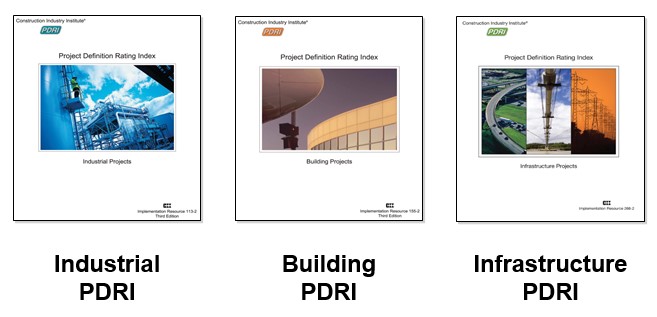Front end planning may be the most important process in the construction and operation of a capital asset. Industry research shows that projects with intensive front end planning efforts and a well-defined scope perform markedly better in terms of total cost, schedule performance and change orders than those with less intensive front end planning efforts. Front end planning is the process of planning and design that takes place early in a projects lifecycle “at a time when the ability to influence changes in design is relatively high and the cost to make those changes is relatively low.” (http://en.wikipedia.org/wiki/Front-end_loading)
As a project moves through front end planning, three cornerstones of success need to be established: people, processes, and systems. But how can you best get there? How do you know if you have the right people, the right processes and systems in place to complete a front end planning effort that increases the likelihood of a successful project?
If only there was a process you could adopt that would give you a definitive score and risk profile on the scope definition of your project…
This is why PDRI was created.
PDRI is an acronym that stands for Project Definition Rating Index. It is an index that helps score the level of scope definition on a continuum that will change as you progress through the stages of front end planning. PDRI is one of the most comprehensive risk management tools available for front end planning. It is used by organizations around the world in both greenfield and renovation and revamp capital projects.
The PDRI methodology was developed by the Construction Industry Institute, or CII. CII is a non-profit research consortium of over 140 members that includes owners, engineering and construction contractors, suppliers and academic institutions that specialize in construction management and engineering. CII’s mandate is to “measurably improve the delivery of capital facilities.”
Over the past 20 years, ten research teams have worked collaboratively to develop industry best practices in front end planning, including the PDRI methodology. To date, over $96 billion in projects have been used to create industry benchmarks using CII’s front end planning best practices.
There are three primary benefits for project teams that have adopted PDRI:
- It is proven method to quantify the level of scope development during front end planning. After a PDRI session your project team knows what and where gaps exist.
- It is an excellent method for promoting alignment between everyone on your project team – regardless of whether you represent the Owner or a design contractor. When we work together through the PDRI session, we have an opportunity to highlight any poorly defined areas or gaps in scope definition in an objective manner.
- All of our efforts in this session help to identify risks and feed into the project’s risk assessment process.
PDRI sessions are held at multiple points in the front end planning processes. The first session, or PDRI-1, is typically held at the end of feasibility, prior to a gate review. The second session, or PDRI-2 is held at the end of the concept stage. In large projects, a PDRI 2-i, meaning an intermediate session, can be conducted as part way through detailed scope. And finally, a PDRI-3 session is conducted at the end of detailed scope and immediately prior to your gate review to proceed into execution.
 Not all organizations use all four-application points. In practice, organizations that successfully implement PDRI as a stage gate deliverable generally conduct a minimum of two sessions for each project.
Not all organizations use all four-application points. In practice, organizations that successfully implement PDRI as a stage gate deliverable generally conduct a minimum of two sessions for each project.
PDRI provides a comprehensive scope definition review spanning the basis of project decision, the basis of design, and the execution approach – effectively determining how well you have defined the Why, Who, What and How of the project:
Why – why are we doing this particular project? Are there better places for us to spend our time and capital?
“There is nothing so useless as doing efficiently that which should not be done at all.”
Peter Drucker
Who – have we got the right people involved? Are there human resource gaps that will prevent success?
What – what will it look like? What equipment, regulatory, environmental, site and technical design elements need to be evaluated?
How – how will we build it?
 PDRI provides a comprehensive scope definition review spanning the basis of project decision, the basis of design, and the execution approach. Each of these three sections is broken down further into categories and elements. The Infrastructure template that we see above includes 68 elements. As shown in our pie chart, the basis of project decision represents almost half of the total risk we’ll evaluate for each industrial project.
PDRI provides a comprehensive scope definition review spanning the basis of project decision, the basis of design, and the execution approach. Each of these three sections is broken down further into categories and elements. The Infrastructure template that we see above includes 68 elements. As shown in our pie chart, the basis of project decision represents almost half of the total risk we’ll evaluate for each industrial project.
There are three versions of PDRI that are available:
 Industrial projects. This includes a broad range of capital projects that typically have extensive piping and mechanical equipment considerations. This includes power plants, chemical plants, refineries, water and waste treatment, and manufacturing just to name a few.
Industrial projects. This includes a broad range of capital projects that typically have extensive piping and mechanical equipment considerations. This includes power plants, chemical plants, refineries, water and waste treatment, and manufacturing just to name a few.
Building projects. This template is tailored specifically to commercial building projects, such as offices, medical facilities, institutional buildings and government facilities.
Infrastructure projects. This includestransportation, pipelines, transmission and distribution just to name a few. These projects typically cover a large geographic area with many stakeholder groups, right of way and environment considerations.
No one will argue with the fact that wise capital expenditure is critical to the success of any business, yet history is riddled with projects going well over budget, well past schedule, and failing to meet operational objectives. Most companies have recognized the need for proper front end planning to ensure successful project execution, but getting there seems almost unattainable. Improving the success rate of your capital projects, even by a few percentage points can turn you from a project zero to a project hero. PDRI is here to help.


